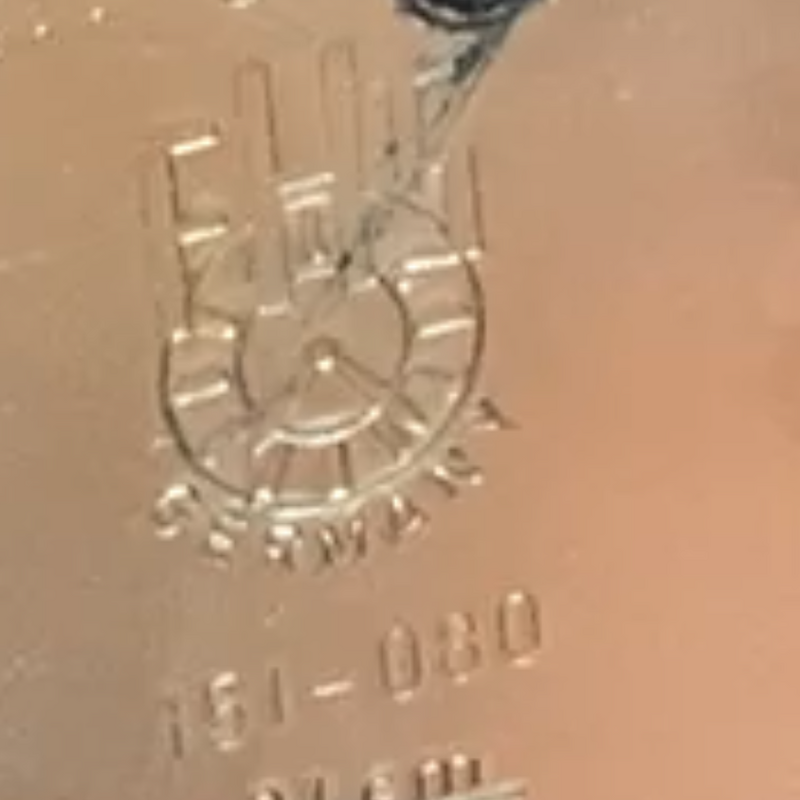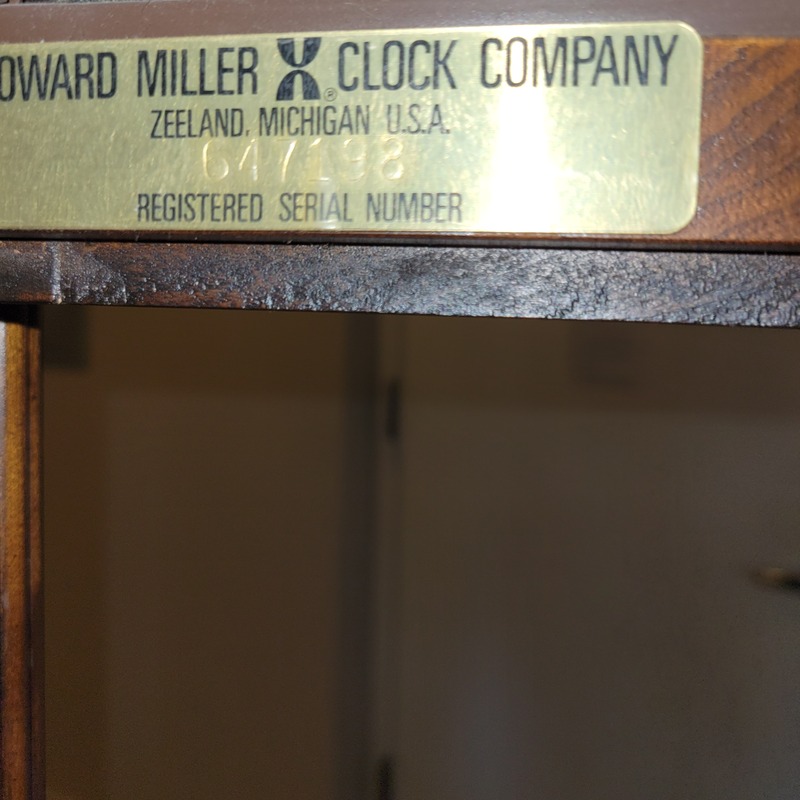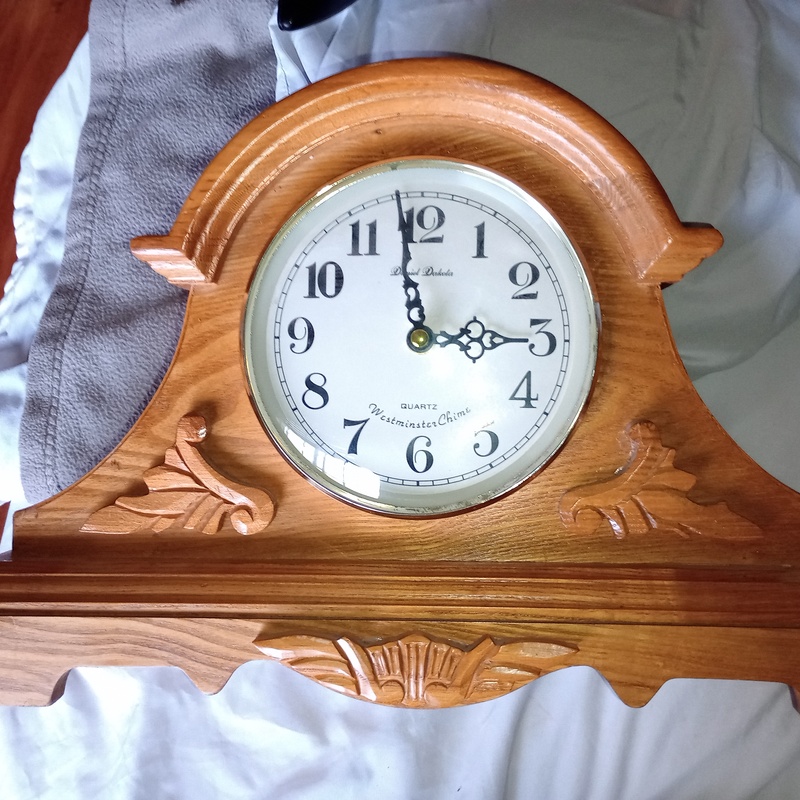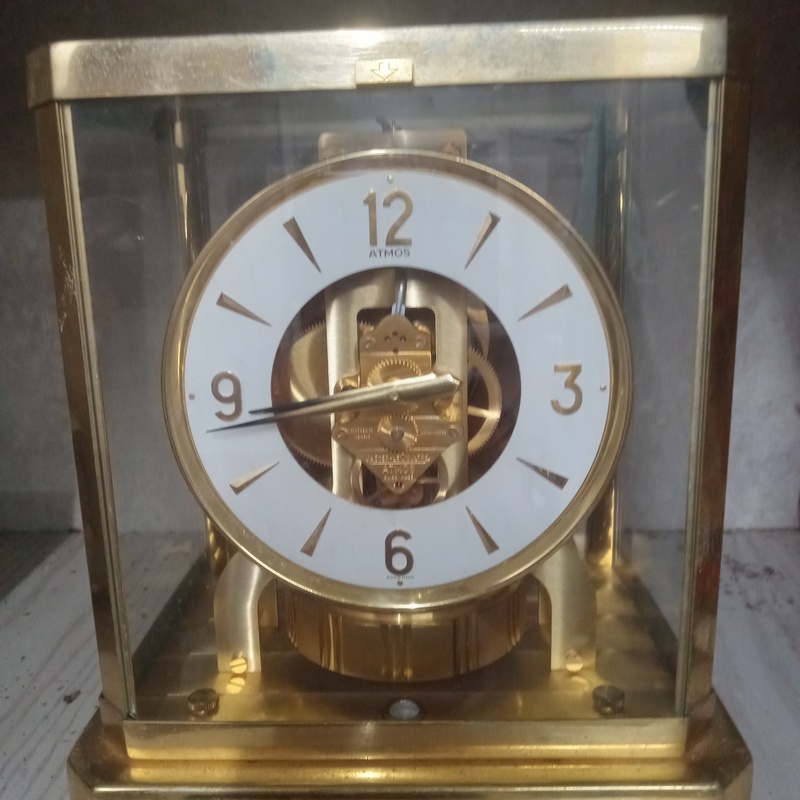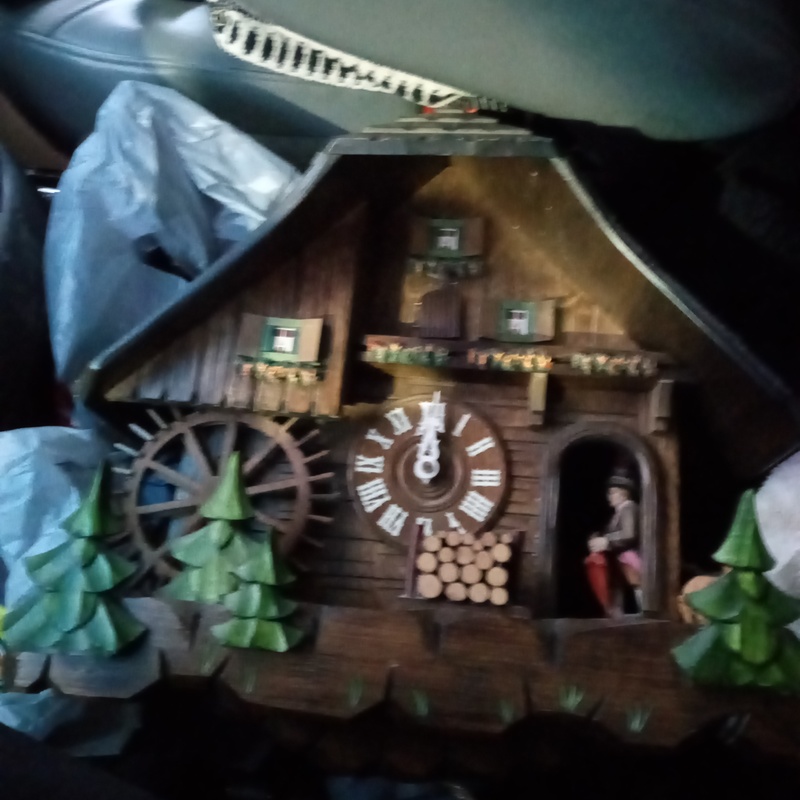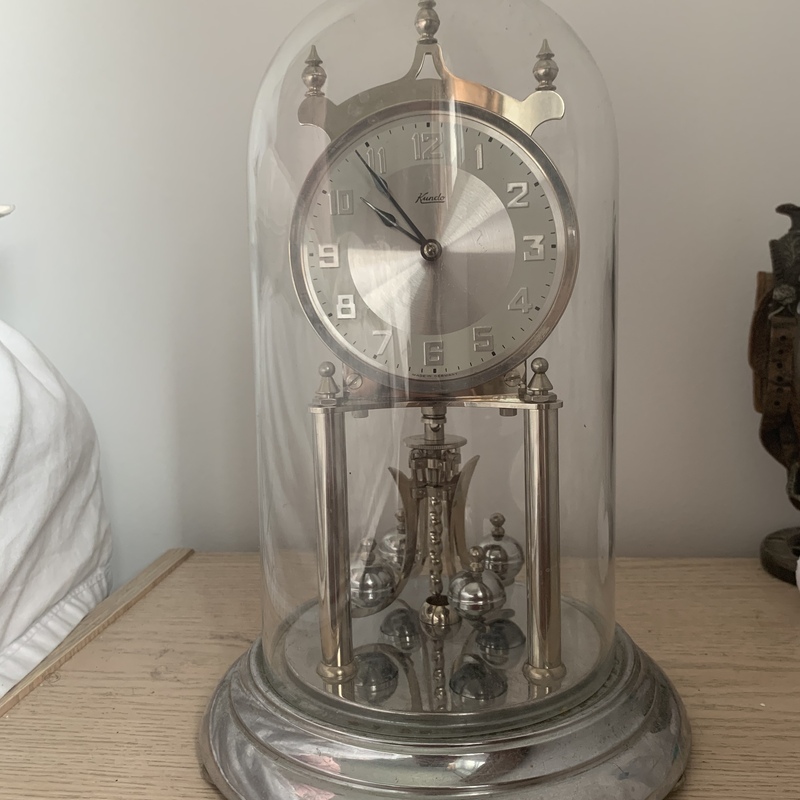
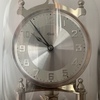
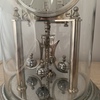
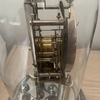
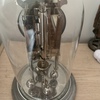
Antique clock
Antique Clock, grand pa use to have it at home years ago, no battery clock really heavy fragile.
Grand pa use to have it years ago.
Inherited
Maybe


Hello Josée,
Thank you for sending in this mantel clock to mearto.com for n appraisal. I shall try to help you with that today.
TITLE:
Chromed metal, brass and glass, 400 -day torsion pendulum timepiece under glazed dome, "Anniversary clock", standard model, made by Kundo Clocks (made by the Kieninger & Obergfell Uhrenfabrik, Black Forest region of Germany, circa third quarter of the 20th century.
DESCRIPTION:
This is the traditional style or standard 400 Day Clock made by Kieninger & Obergfell (aka Kundo) in southeastern Germany. This desk timepiece is fully chrome plated (except for the movement), stands on a concentric round chromed base and is covered with a glass dome. The clock dial is surmounted by an arched chromed pediment supporting three chromed ball and short spire finials. The bezel is also chromed. The dial is supported by two chrome plated pillars each topped by an ornamented ball and short spire finial.
Dial: A two tone silvered dial with applied chromed or silvered Arabic hours, open bar minute ring to the outside, a polished silvered dial center marked ‘Kundo’ in script
And has steel Spade hands. The base of the dial is marked, ‘Made in Germany’.
Movement: A rectangular chromed steel or brass plate movement with tubular pillars connecting the plates at the four corners and attached by screws to the rear plate. The movement is time only (non-striking) and is powered by a single steel barrel spring. The backplate carries the logo of the Kieninger Obergfel company logo with writing that is illegible to me. The pendulum hangs from a single suspension wire (a particular type of wire, and will not run with any normal piece of wire) and a bob at the bottom that consists of a four ball (each chromed metal) bob, made into a single unit. The bob can be adjusted to expand and contract by adjusting screws to remain in balance and swing slightly faster or slightly slower, much like an ice skater who slows down by extending the arms or goes faster by pulling the arms towards the body. The bob can be screwed down so that it does not move and can be transported safely. The impulse provided by the single spring is delivered to the wire with just enough power to cause the torsion spring to wind and unwind very slowly. This power causes the spring to unwind extremely slowly in its brass barrel, and therefore the movement will function for approximately 400 days.
Condition: The clock appears to b in very good to excellent condition. I will assume all parts are original and continue to function. The chromed examples are not terribly common.
HISTORY:
~Kieninger & Obergfell=KUNDO:
Founded in 1899 by Johann Obergfell, this company initially made gears and clock parts in St. Georgen in the Black Forest region of Germany. Obergfell invented the rod gong. in 1918 he expanded the company in partnership with Georg Kieninger producing mantel, wall and standing clocks. He registered the trade name Kundo during this period and began producing anniversary type mantel clocks. They added a branch factory in 1964 and further expanded in 1972 to meet growing demand. Under the name Kundo they introduced a line of electrically driven clocks. Distribution was worldwide. Kundo clocks refer to clocks made by the German company Kundo, the trade name of Kieninger & Obergfell, during the 20th century. Kundo was one of the leading anniversary clock manufacturers during the early and mid-20th century. Kundo anniversary clocks were first produced in 1923
~Anniversary clock, under dome:
These types of clocks were known as torsion clocks, 400-day clocks or Anniversary clocks. The first refers to the twisting motion of the pendulum spring, the second to the duration of activity with one winding and the latter to the fact that it was frequently given as a gift. The first commercially successful year clock was patented in 1841 by Aaron Crane of New Jersey and marketed by his company, The Year Clock Company of New York City. This was housed in a substantial and heavy wooden case, unlike the modern 400-day clock. ----------- The torsion pendulum as we know it today was patented by Anton Harder in 1880 in Austro-Hungary. This was a small movement with a torsion pendulum on a circular wooden or metal base under a glass dome. The early examples were made by A. Willman, Gustav Becker and The Fortuna Clock Company. Technical problems caused slow production which actually slowed to a halt because the experimental problems had not yet been resolved. They proceeded to contact August Schatz to see if he could improve their design and create a clock that could be mass produced. The German firm of Schatz and Sohne in 1881 was the first successful manufacturer of this type of clock. In March 1884 the firm was called Jahresuhren-fabrik AG. (Literally translated as year running clock producers). In 1898 it became Jahresuhren-fabrik GmbH. Finally, in 1923 it became the Jahresuhren-fabrik August Schatz & Sohne. The firm had to compete with at least a dozen German clock factories producing this type of Anniversary clock along with a single French firm, in the years leading up to WW l. JUF Schatz produced thousands of these anniversary clocks in the years between the 1880's and WWll. Most clocks were made for export to America. Multiple patents were taken out, including a bell striking example which was not successful. The case styles were mainly a circular metallic base covered by cloth or velvet; a small movement usually surmounted with a number of tiny brass finials. The movement sat on two brass posts and the brass pendulum attachment hung from a torsion suspension spring. The most collectable examples were made prior to WW1 and these had a pendulum bob that was a round brass disc that turned first in one direction and then the other. There were two smaller discs mounted on the top surface connected by a pin. The early bases were made of a soft wood with a brass outer covering. Later examples showed the disc attached to the spring with a hook. The early dials were enamel, the later ones plastic. The numbers of these clocks produced virtually exploded in the years between the World Wars. Competition was fierce! It was during this time that the four-ball arrangement of the pendulum came into use. Production ceased during the War, but resumed in 1946. After WW2 these clocks continued to be made in significant number. By 1949 new designs and patents were developed and the earliest of these new models contained the number 49 in its logo or trademark. In 1953 a miniature model was produced. Starting in 1950 Schatz began to place a date on the rear brass plate of the movement, so that dating the clock becomes quite easy. Clocks from the circa 1950 era had a metal dial that was silvered and a classic black chapter ring with an etched design. The clock was highly polished and had a lacquered brass finish. Post 1953 models had features which included leveling screws to the base, a device to lock the pendulum in place for transportation and at times a liquid level with a bubble set into the base. Repair requires a skilled clock repair person. Original glass domes are hard to come by if they break, and the originals add to the value of the clock.
COMPARABLES:
https://www.liveauctioneers.com/item/86558265_a-mid-20thc-kundo-anniversary-clock-with-a-glass-dome (Sold in 2020 for 20 GB Pounds)
https://www.liveauctioneers.com/item/79607706_anniversary-clock-kundo-german-glass-dome-germany (unsold because it failed to reach $40 at auction in 2019)
https://www.liveauctioneers.com/item/85021920_kieninger-and-oberfell-anniversary-clock (sold for $45 on 2020)
PRICING:
These clocks have always been quite reasonable in price and so many were manufactured that they fail to reach the $50 mark on a regular basis. I believe your example is fine enough to reach that mark and I think the fair market value would be in a range of $40-$60.
I hope this helps you to understand your little domed clock, its history and the popularity of this particular invention, just as popular with the public today as it was throughout the 20th century. I hope you continue to enjoy this family timepiece.
Thank you for choosing mearto.com
My best,
David

